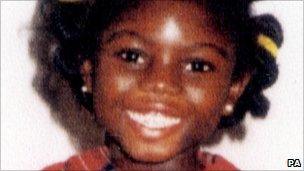The end of a child protection revolution
- Published

Victoria Climbie had many injuries when she died
A computer system that was meant to revolutionise the way in which professionals track vulnerable children is being switched off, quietly and without fanfare, later on Friday.
Called ContactPoint, it would eventually have contained the names and basic details of every one of the 11 million children living in England.
But the Conservatives had always believed the solution was disproportionate to the problem and pledged in its coalition agreement with the Liberal Democrats to scrap it.
Within two months of the switch-off all the data collected for the system is to be destroyed.
The Laming Inquiry into the death of Victoria Climbie had recommended that a national database of children should be set up to avoid another child being hurt in the same way.
Different hospitals and different local authorities had come in contact with the eight-year-old as she was moved around London, but no professional had a complete picture.
ContactPoint divided opinion from the outset. Civil liberties campaigners claimed it was an unwarranted intrusion into family life and serious concerns were also raised about the safety of so much information being held in one place, given the government's track record on keeping data safe.
On the other hand, many organisations working in the field of child protection felt that it could be an important tool in helping professionals find out who was working with a vulnerable child. They also felt it would improve the sharing of information.
After much delay, and increasing cost, the national roll-out of the system began in January 2009.
To date, some 15,000 users have accessed it, against the forecasted 330,000.
Tracing children
By the end of March this year, some £235m has been spent on the project.
But a report published by the Labour government said 75% of the professionals piloting the system had found it useful.
It quoted an attendance officer in one area who said he had been able to trace eight children who had been missing from education for more than a year.
With echoes of the Climbie case, a social worker also described a mother who had been going to different agencies using different names for her child.
ContactPoint helped them discover that there had been five different stories given for the same child.
Once they had that information they could protect that child properly.
Child deaths
After so much time and money has been put into setting up one system, the Association of Directors of Children's Services says it is concerned that the effort should not be wasted.
They also say focus must not be lost on the need for professionals to know who else is working with a vulnerable child.
Certainly time and again, reviews into child deaths have pointed to a lack of information-sharing between agencies.
The most recent was last week's serious case review into the starving to death of seven-year-old Khyra Ishaq in Birmingham.
The coalition government says it does recognise the problem that the system was meant to address.
It just wants a more proportionate approach focused solely on vulnerable children and used by front-line staff only.
It is exploring the possibility of a national signposting service.
Ideas will be considered by the Munro Review into child protection, but its full report is not due until next year.